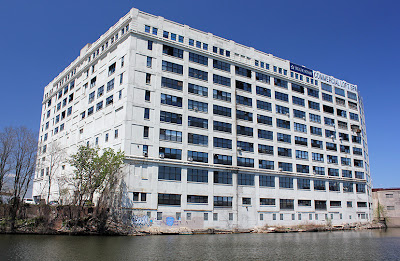 |
| click images for larger view |
It's part of the long-term transformation that began with the the eminent domain acquisition by the Chicago Park District of a 12-acre riverfront site south of 18th street that had held a Chicago and Western Indiana rail yard. Under the direction of Ernest Wong's Site Design Group the site became Ping Tom Memorial Park, named after the Chicago businessman and developer who hired Harry Weese to design the nearby Chinatown Square shopping center.
The Armour Square neighborhood has been Chicago's Chinatown ever since the first business moved there in 1911 from a two-block stretch of South Clark Street in the Loop. The community's only two parks were demolished in the 1960's to make way for the construction of Dan Ryan expressway, and so it remained until Ping Tom, with it's traditionally-styled pagoda pavilion and quartet of twenty-feet-high columns opened in October of 1999.
A few years later, north of 18th street, the Park District combined five newly acquired acres with six more already owned to form Ping Tom Phase 2, united through an under-the-bridge passage with the original portion of the park to the south.
TIF money was used to build a retaining wall and natural features along the riverbank, and Phase 2 opened in 2011, the same year new mayor Rahm Emanuel announced the construction of four new boathouses along the river, including one at Ping Tom, part of an initiative to transform the park's status from neighborhood to regional.
The new Ping Tom boathouse is much less ambitious than the 20,000 square-foot Clark Park boathouse, designed by Studio/Gang, being constructed along the Chicago River north of Belmont, heading towards an August 3rd dedication. I'm still not quite sure why the Johnson and Lee boathouse didn't wind up on the much narrower site at Clark Park, and the larger Studio/Gang facility, which is to be home to rowing clubs and regattas, situated on the far wider river at Ping Tom. I'm sure they had their reasons.
Johnson and Lee may not have Studio/Gang's cachet - or daring - but their Ping Tom boathouse is an attractive, colorful work. There are three basic parts. The storage pavilion for kayaks and canoes, open and airy, is contained within metal screens painted the requisite red.
The service portion of building joined to it, housing restrooms and office space, is dark and solid. Uniting both sections is a tall free-standing canopy, painted a neutral, mediating white, facing out to a walkway that descends to the river and a floating dock.
Less attractive is the $13 million, 28,0000-square-foot field house,. It won't be finished until later this year, but judging from its current appearance, it looks to be just as anonymous as its Prototype-A design designation would suggest.
The field house was originally slated to be placed along the 18th Street bridge, but when buried track from the former railyard and concrete remnants of a roundhouse were discovered 5 to 12 feet underground, along with a lot of unwanted groundwater, the site was moved to a placement along the St. Charles Airway rail line. The upside is that this resulted in several million dollars in savings, making possible an indoor pool that Park District Director of Planning Gia Biaggi told the Chicago Journal was the first built by the CPD in her more than 12 years with the agency.
The distinctive character of Ping Tom Park derives from the confluence of three strong facets of Chicago. First of course, as an extension of the city's increasingly vibrant Chinese-American community. Then the geography of the river. And lastly, the one most likely to be overlooked, or even seen as an impediment - the park's immersion within Chicago's historic industrial presence.
Beyond the occasional train chugging along to the east, Ping Tom sits between two historic bridges. To the north, there's the 1919 (relocated) St. Charles Air Line bascule bridge. To the south, another great landmarks (they're both official): the 1914 Canal Street (now Amtrak) bridge, with its spectacular twin 195-foot-high towers and the tiny, bridge-tender house perched atop the central span. (Control facilities were moved to a side structure long ago, but the grunge-dollhouse endures.)
Between St. Charles and Amtrak, the bridgehouse of the 1967 18th Street bridge, city-designed, strikes a handsome, more contemporary note.
 |
| 18th Street Bridge House, Schoenhofen Brewery in background to right |
The first roadway west of the river? Lumber Street, of course.
The new boathouse was dedicated with a mini extravaganza, with traditional Chinese dancers, communal fishing, and the Chicago Symphony brass section floating down the river (in a boat) with Music Director Riccardo Muti, who came ashore to conduct a performance - complete with repeat - of the Josephine Lee's Chicago Children's Choir singing Verdi's Va Pensiero. Between the obligatory press statement and heading out to meet Muti's boat, Mayor Rahm Emanuel could be found listening to the Civic Orchestra's brass players, looking a relaxed and happy man.
And well he should. It's a very positive sign to see the big marque projects most often crammed into the center of the city moving out into Chicago's working class neighborhoods.
It's all a matter of balances. Between a comfortable neighborhood park, and a buzzing but more impersonal regional one. Between the city as it was - and is - and the city as it's becoming. Between revitalization and gentrification. Right now, Ping Tom Park and its handsome new boathouse is at the sweet spot.
Read More:
Studio/Gang's Clark Park Boathouse: A Century of Transformation flowing down Chicago's River















No comments:
Post a Comment